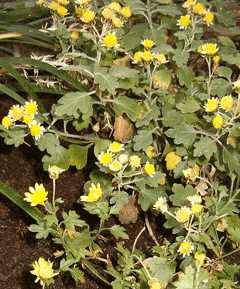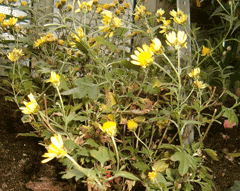 |
|
http://commons.wikimedia.org/wiki/User:BotBln |
 |
| http://commons.wikimedia.org/wiki/User:BotBln |
Translate this page:
Summary
Physical Characteristics

 Chrysanthemum indicum is a PERENNIAL growing to 0.6 m (2ft) by 0.6 m (2ft in).
Chrysanthemum indicum is a PERENNIAL growing to 0.6 m (2ft) by 0.6 m (2ft in).
See above for USDA hardiness. It is hardy to UK zone 6. It is in flower from August to October. The species is hermaphrodite (has both male and female organs) and is pollinated by Insects.
Suitable for: light (sandy), medium (loamy) and heavy (clay) soils. Suitable pH: mildly acid, neutral and basic (mildly alkaline) soils. It cannot grow in the shade. It prefers moist soil.
UK Hardiness Map
US Hardiness Map
Synonyms
Chrysanthemum indicum. L.
Plant Habitats
Edible Uses
The flower heads are pickled in vinegar[46, 61, 177, 183]. Young leaves - cooked[105, 177, 183]. An aromatic tea is made from the leaves[183]. Seed[183]. No more details are given but it is very small and would be rather fiddly to use.
References More on Edible Uses
Medicinal Uses
Plants For A Future can not take any responsibility for any adverse effects from the use of plants. Always seek advice from a professional before using a plant medicinally.
The whole plant is antiphlogistic, blood tonic, depurative, febrifuge and vulnerary[147, 174, 178]. The plant is used in China to treat eye ailments[218]. In conjunction with black pepper it is used in the treatment of gonorrhoea[240]. The leaves are depurative[240]. They are used in China in the treatment of migraine[240]. The flowers are aperient, bitter, hypotensive, stomachic and vasodilator[176, 240]. They contain the glycoside chrysanthemin that yields glucose and cyanidin on hydrolysis, together with stachydrine and an essential oil[283]. They have an antibacterial action, inhibiting the growth of Staphylococcus, E. coli, streptococcus, C. diphtheriae, Bacillus dysenteriae[176]. The flowers are used in the treatment of furuncle, scrofula, deep-rooted boils, inflammation of the throat, eyes and cervix, eczema, itchiness of the skin and hypertension[176]. They have a rejuvenating effect when used over a long period of time[283]. An essential oil obtained from the plant contains chrysanthenone, this is active on the brain centre affected by Parkinson's disease[240].
References More on Medicinal Uses
The Bookshop: Edible Plant Books
Our Latest books on Perennial Plants For Food Forests and Permaculture Gardens in paperback or digital formats.

Edible Tropical Plants
Food Forest Plants for Hotter Conditions: 250+ Plants For Tropical Food Forests & Permaculture Gardens.
More

Edible Temperate Plants
Plants for Your Food Forest: 500 Plants for Temperate Food Forests & Permaculture Gardens.
More

More Books
PFAF have eight books available in paperback and digital formats. Browse the shop for more information.
Shop Now
Other Uses
The seed contains about 16% of a semi-drying oil, but no information is given as to its uses[240, 283]. The seed is rather small, commercial extraction is probably not viable[K].
Special Uses
References More on Other Uses
Cultivation details
Succeeds in most well-drained fertile soils in a sunny position[1, 200]. Plants tolerate temperatures down to about -10°c and should succeed outdoors in most parts of Britain[260]. This species is closely related to D. x grandiflorum (the cultivated chrysanthemum) according to one report[58] whilst another says that it is a parent of the cultivated chrysanthemum[1]. It has been proposed (1999) to restore this species to Chrysanthemum as C. indicum L. since the plant is so widely known under this name. When bruised, the foliage has a pungent refreshing fragrance that is somewhat lemon-like and reminiscent of chamomile[245].
References Carbon Farming Information and Carbon Sequestration Information
Temperature Converter
Type a value in the Celsius field to convert the value to Fahrenheit:
Fahrenheit:
The PFAF Bookshop
Plants For A Future have a number of books available in paperback and digital form. Book titles include Edible Plants, Edible Perennials, Edible Trees,Edible Shrubs, Woodland Gardening, and Temperate Food Forest Plants. Our new book is Food Forest Plants For Hotter Conditions (Tropical and Sub-Tropical).
Shop Now
Plant Propagation
Seed - sow spring to early summer in a greenhouse and only just cover the seed[200]. It usually germinates in 10 - 18 days at 15°c but if it does not germinate within 4 weeks then try chilling the seed for 3 weeks in the salad compartment of a fridge[164]. When they are large enough to handle, prick the seedlings out into individual pots and plant them out in the summer. Division in spring. Larger clumps can be replanted direct into their permanent positions, though it is best to pot up smaller clumps and grow them on in a cold frame until they are rooting well. Plant them out in the spring.
Other Names
If available other names are mentioned here
Native Range
TEMPERATE ASIA: China (Anhui Sheng, Fujian Sheng, Guangdong Sheng, Guizhou Sheng, Hebei Sheng, Heilongjiang Sheng, Henan Sheng, Hubei Sheng, Hunan Sheng, Jiangsu Sheng, Jiangxi Sheng, Shandong Sheng, Sichuan Sheng, Yunnan Sheng), Japan (Honshu, Kyushu, Shikoku), Korea, South, Korea, North, Taiwan
Weed Potential
Right plant wrong place. We are currently updating this section.
Please note that a plant may be invasive in one area but may not in your area so it's worth checking.
Conservation Status
IUCN Red List of Threatened Plants Status :

| Related Plants
|
| Latin Name | Common Name | Habit | Height | Hardiness | Growth | Soil | Shade | Moisture | Edible | Medicinal | Other |
| Artemisia vulgaris | Mugwort, Common wormwood, Felon Herb, Chrysanthemum Weed, Wild Wormwood | Perennial | 1.2 |
3-9
| F | LMH | SN | DM | 2 | 3 | 3 |
| Chrysanthemum carinatum | Tricolor Chrysanthemum, Painted Daisy, Summer Chrysanthemum | Annual | 0.6 |
0-0
| F | LMH | SN | M | 2 | 0 | |
| Chrysanthemum coronarium | Chop-Suey Greens | Annual | 1.2 |
0-0
| | LMH | SN | M | 3 | 2 | 2 |
| Chrysanthemum coronarium spatiosum | Chop-Suey Greens | Annual | 1.2 |
0-0
| | LMH | SN | M | 3 | 2 | 2 |
| Chrysanthemum marshallii | | Perennial | 0.0 |
-
| | LMH | SN | M | 0 | 0 | 3 |
| Chrysanthemum segetum | Corn Marigold | Annual | 0.5 |
-
| | LMH | SN | M | 1 | 0 | |
| Dendranthema indicum | Chrysanthemum | Perennial | 0.6 |
5-9
| | LMH | N | M | 2 | 3 | 1 |
| Dendranthema x grandiflorum | Chrysanthemum, Cut Mum, Garden Mum, Pot Mum, Florist's Chrysanthemum | Perennial | 1.5 |
5-10
| M | LMH | N | M | 2 | 3 | 2 |
| Leucanthemum maximum | Shasta Daisy, Max chrysanthemum | Perennial | 0.8 |
5-9
| | LMH | N | M | 0 | 0 | |
|
Growth: S = slow M = medium F = fast. Soil: L = light (sandy) M = medium H = heavy (clay). pH: A = acid N = neutral B = basic (alkaline). Shade: F = full shade S = semi-shade N = no shade. Moisture: D = dry M = Moist We = wet Wa = water.
Now available:
Food Forest Plants for Mediterranean Conditions
350+ Perennial Plants For Mediterranean and Drier Food Forests and Permaculture Gardens.
[Paperback and eBook]
This is the third in Plants For A Future's series of plant guides for food forests tailored to
specific climate zones. Following volumes on temperate and tropical ecosystems, this book focuses
on species suited to Mediterranean conditions—regions with hot, dry summers and cool, wet winters,
often facing the added challenge of climate change.
Read More
Expert comment
Author
(L.)Des Moul.
Botanical References
58200266
Links / References
For a list of references used on this page please go here
Readers comment
| Add a comment |
|
If you have important information about this plant that may help other users please add a comment or link below. Only comments or links that are felt to be directly relevant to a plant will be included. If you think a comment/link or information contained on this page is inaccurate or misleading we would welcome your feedback at [email protected]. If you have questions about a plant please use the Forum on this website as we do not have the resources to answer questions ourselves.
* Please note: the comments by website users are not necessarily those held by PFAF and may give misleading or inaccurate information.
To leave a comment please Register or login here All comments need to be approved so will not appear immediately.
|
Subject : Chrysanthemum indicum
|
|
|
|